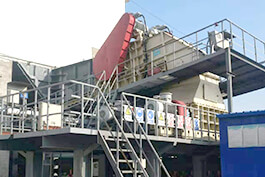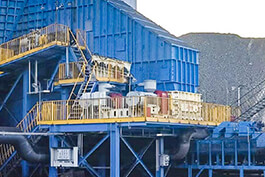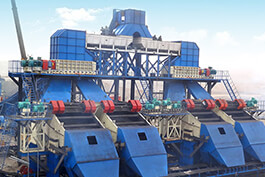I. Definition
A
feeder breaker is a piece of equipment used in industries such as coal mining and mineral extraction, particularly in open-pit mining. It is a mining device that integrates the functions of crushing, feeding, and conveying materials. A long-standing challenge for mining equipment is wear resistance, as it directly affects the service life of the feeder breaker and the overall operational costs of the mining industry. The core feature of a feeder breaker is the "through-type" flow of materials in the crushing chamber, where feeding, crushing, and discharging occur continuously, making it suitable for large-scale industrial production scenarios.
II. Structural Composition
The feeder breaker is composed of processed parts, cast parts, purchased components, and assembled parts. It is also made up of a chain conveyor and a crushing unit. The complete system of the feeder breaker achieves the integration of feeding and crushing functions.
The structural composition of the feeder breaker is centered around functional integration, primarily comprising five major modules:
(1) Basic Frame System: Constructed from high-strength steel, it includes the frame, base, and side panels. The frame is equipped with reinforcing ribs to withstand impacts, while the base is fitted with shock-absorbing devices. The side panels integrate a flared feeding inlet and a discharge outlet, which seamlessly connect to subsequent conveying systems.
(2) Crushing Unit: Divided into hammer-type and toothed roll types.
Hammer-type: Comprises a rotor shaft, hammer frame, and hammer heads (made of high-manganese steel with adjustable gaps).
Toothed roll-type: Consists of a driving roll and a driven roll (with spiral teeth or cutting teeth, and a built-in cooling system), adapting to the crushing needs of different materials.
(3) Feeding and Conveying System: The chain conveyor (with drive sprockets, chains, and anti-stick hoppers) is responsible for material feeding. The pre-screening device is divided into a static grate (to intercept impurities) and a dynamic screen (to prevent material jamming), achieving pre-processing of materials.
(4) Power and Transmission System: Driven by a motor-reducer combination, the power is matched according to working conditions. Power is transmitted via belts, gears, or couplings to ensure synchronous operation of crushing and conveying.
(5) Wear-Resistant Protection Components: Key components (such as the inner wall of the crushing chamber and hammer heads) use wear-resistant liners, coatings, or composite materials to extend equipment lifespan and reduce maintenance costs. These modules work synergistically to ensure continuous and efficient production.
III. Core Working Principles
The operation of a feeder breaker is based on the following key mechanisms:
1. Feeding and Pre-Screening
Materials are evenly fed into the crushing chamber through the feeding device, and large impurities (such as metal and wood) are removed by a pre-installed grid screen.
2. High-Speed Impact Crushing
The rotor drives the hammer heads or toothed rolls to rotate at a linear speed of 20–50 m/s, crushing materials through impact, shearing, and extrusion.
3. Particle Size Control
An adjustable screen plate or grid controls the discharge particle size, and unqualified materials continue to circulate for re-crushing.
4. Continuous Discharging
Crushed materials are directly discharged under gravity or centrifugal force, eliminating the need for additional conveying equipment.
IV. Roles and Functions
1. Fundamental Roles
(1) Coarse and Medium Crushing of Materials
Feeder breakers can crush large raw materials (such as raw coal, limestone, and gypsum) into particle sizes suitable for subsequent processing (typically 200–500 mm), meeting the requirements for belt conveying, screening, or further fine crushing.
(2) Improving Material Uniformity
Through the high-speed rotation of the rotor and the impact of hammer heads or toothed rolls, the crushed materials have a more uniform particle size distribution, preventing blockages or efficiency degradation in subsequent processes caused by particle size variations.
2. Unique Roles and Advantages
Compared with feeder breakers from other brands, our company’s feeder breakers have unique pre-screening functions and optional crushing modes.
(1) Pre-Screening Function
There are two pre-screening methods: dynamic pre-screening and static pre-screening, which can be configured according to different working conditions.
The material receiving section uses static screening. The static screening grate is fixed on the conveying box through rails, suitable for screening large-particle materials.
The non-material receiving section uses dynamic screening. The conveying box is integrated with a specially designed sinusoidal vibrating screen mesh, suitable for screening small-particle and sticky materials. The sinusoidal vibrating screening method in the non-material receiving section prevents material jamming.
Benefits and roles of the pre-screening function: By pre-screening materials before crushing, over-crushing is avoided, the generation of powdery materials is reduced, the output of mineral lumps is maximized, and the economic benefits and value for end users are improved.
(2) Optional Crushing Modes
Our company’s toothed roll crushers and hammer crushers provide customers with optional crushing modes.
• Powerful toothed roll crushers are equipped with cutting teeth and a cutting tooth pattern specially designed for chain conveyors, which can crush materials to the required output size. Since materials are crushed rather than flattened, the particle size is uniform, reducing waste and maximizing product value.
Benefits and roles of toothed roll crushers: The crushing teeth are made of special formula materials through precision casting and heat treatment, featuring high strength, wear resistance, and impact resistance. The unique and innovative tooth-shaped design with deep spiral distribution ensures strong biting ability and high production efficiency.
• Hammer crushers are connected to the motor via V-belts. The height of the hammer crusher can be quickly adjusted by a hydraulic device to regulate the discharge particle size of crushed materials, meeting the needs of different customers.
Benefits and roles of hammer crushers: The tooth heads adopt a modular design and are fixed to the crushing hammer with high-strength bolts, enabling targeted and efficient replacement of individual tooth heads.
The crushing mode using crushing hammers is particularly effective for extra-large materials in open-pit mines. Hammer crushers are new-type crushers developed for large-particle materials, featuring wear resistance, large processing capacity, and long service life.
V. Conclusion
Feeder breakers play a pivotal role in modern mining and material processing industries by integrating feeding, crushing, and conveying functions. Their ability to handle large volumes of materials efficiently, coupled with specialized designs for wear resistance and adaptability to diverse materials, makes them indispensable for optimizing production flows and reducing operational costs. Whether through pre-screening to enhance material quality or optional crushing modes to meet specific needs,
feeder breakers continue to drive innovation in industrial crushing technology, ensuring sustainability and efficiency in resource utilization.


.jpg)
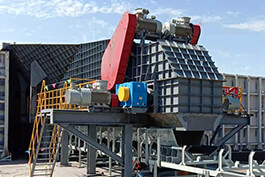
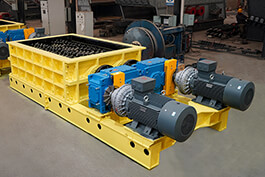
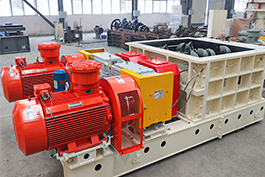
.jpg)
